The Task
Due to the completion of the tunnelling works by BBMV for the Crossrail Project, Keltbridge were appointed to clear the Whitechapel Site. Consequently, Street Cranexpress were invited to tender for the removal of the Kunz crane (tunnelling crane) and a 50t overhead crane which were housed in the acoustic building.
The Crossrail project in London is one the largest construction works in the UK and the Whitechapel site had to be decommissioned after being used as an entrance to the horizontal tunnels, via a vertical shaft. Tunnelling and associated plant were lowered and raised to and from the tunnel and after the work was completed, the shaft was sealed as the lifting equipment was no longer required.
The Solution
To undertake the removal of the two cranes, a section of the building roof and sides was removed. A mobile crane was positioned adjacent to the building which was used to remove the cranes off their respective crane rails.
Removing the Kunz Crane

Mobile crane suspending and lowering the Kunz
- The Kunz crane was removed first.
- Before the crane could be lifted, its weight was calculated, and the appropriate web slings and steel chains were selected to allow for a safe lift.
- Street Cranexpress task engineers attached the slings to the crane bridge beams and the load was balanced using the shortening clutches on the steel chains.
- The crane was lifted from its crane rails, rotated, lowered onto a trailer, and removed from site to be reused elsewhere.
Removing the 10t auxiliary hoist

Task engineers preparing the bridge beam
- Before the 50t overhead crane could be removed, a 10t auxiliary hoist traversed on a bridge beam had to be removed to lighten the load of the crane and make it more balanced when in transit.
- Street Cranexpress task engineers prepared the bridge beam to be removed from the 50t crane.
- The 10t auxiliary hoist was secured central to its bridge beam to prevent movement during transit.

Lowering the bridge beam
- Two web slings were connected to the bridge beam using an “endless choke” method of slinging. They were then attached to the two-leg steel chains suspended from the mobile crane hook.
- The 10t auxiliary hoist bridge beam was balanced using the shortening clutches on the steel chains.
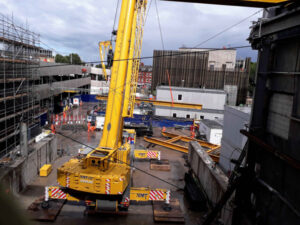
Mobile crane suspending and lowering the bridge beam
- Radios were used to keep in contact with the mobile crane driver and the Appointed Person.
- Tag lines were then attached to the bridge beam to control its movement when it was being lowered.
- The 10t auxiliary hoist was lowered to ground level in preparation to be removed from site.
Removing the 50t hoist crab unit
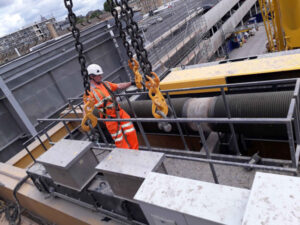
Steel chains were attached to the dedicated lifting points via four
- To lighten the crane weight further, the 50t hoist crab unit was prepared to be removed from the bridge beams.
- The electrical cables which supplied the hoist main control panel for power and control purposes were disconnected.
- The 50t hoist crab unit had dedicated lifting points welded to the crab chassis when it was manufactured for the purpose of transporting the hoist in a balanced state.
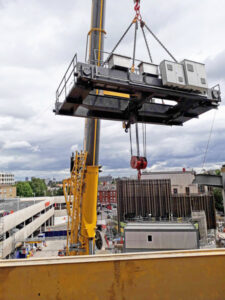
Lifting the 50t hoist crab unit
- Taglines were attached to the 50t hoist crab unit to control its movement during its descent.
- Radios were used to keep in contact with the mobile crane driver and the Appointed Person.
- Two sets of 2 Leg chains with shortening clutches are used to allow the balancing of the hoist crab.
- At each of the dedicated lifting points, “D”- shackles were installed and the chain hooks were integrated into the shackles.
- The 50t hoist crab unit was lifted off its cross-travel rails in a controlled and balanced state.
- As there were no height issues, the hoist was lifted vertically off the cross-travel rails and out of the building.
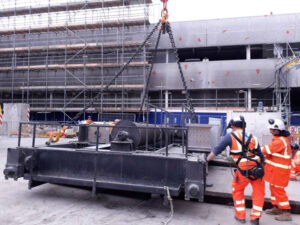
Hoist crab unit removed safely to ground level
- The hoist crab unit was landed on wooden sleepers to protect the hoist components beneath the hoist barrel.
- When the transporter arrives on site the hoist crab will be lifted on the transporter bed using the same lifting techniques.
The 50t Overhead Crane
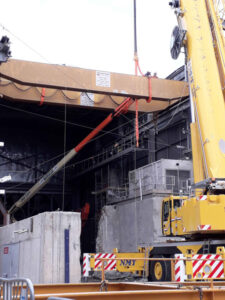
Street Cranexpress task engineers installing web beam
- The final task involved removing the 50t overhead crane which required Street Cranexpress task engineers to work from a cherry picker basket to install the web slings round the bridge beam.
- Four web slings were connected to the bridge beam using an “endless choke” method of slinging. They were then attached to the 2 Leg steel chains suspended from the mobile crane hook.
- At each corner of the web slings are protector pads which will prevent the slings being damaged when the bridge beam is in transit.
- The 50t crane was balanced using the shortening clutches on the steel chains.
- Radios were used to keep in contact with the mobile crane driver and the Appointed Person.
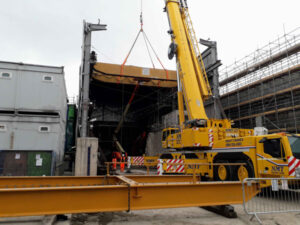
Crane being lifted
- Finally, the crane could be lifted vertically from the building.
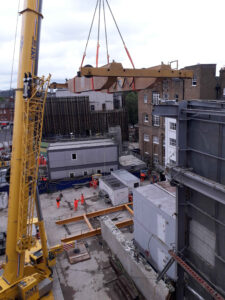
Crane being lowered
- Once the balance of the crane was established, it was lifted off the tracks and out of the building
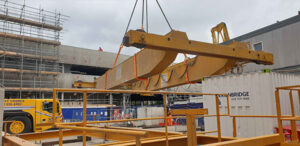
Crane unit removed safely and landed to ground level
- The crane was lowered into a dedicated area.
- When the transporter arrives on site the crane will be lifted on the transporter bed using the same lifting techniques.